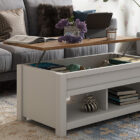Deciding whether solid wood or engineered wood is better is the real bone of contention for most people. Let’s read more to find out on how they weigh against each other.
Both solid wood and engineered wood are extremely popular choices for Indian homes today. But how do you differentiate between the two, what are the types available, and the advantages/disadvantages of each. These are questions that keep hounding you time and again. Here’s a quick guide to help you answer most of your questions!
What Is Solid Wood And What Are Its Types?
Solid wood is defined as ordinary lumber that doesn’t have hollow spaces. It is a natural product made from slabs obtained by cutting down matured and fully-grown trees. If you’re looking for natural wood to build your furniture and construct your flooring you will primarily find two varieties in the market: Hardwood and Softwood.
Softwood takes a shorter time to become usable. White cedar, pine, rubberwood and fir are some examples of softwood. Hardwood comparatively takes a longer time to grow. Walnut, cherry, rosewood, oak, maple and teak are some examples of hardwood.

What Is Engineered Wood And What Are Its Types?
Engineered wood is defined as derivative wood products that are manufactured by binding together fibers, wood strands, particles or veneers with certain adhesives or other fixation methods to form a composite material under heat or pressure. It is also known as man-made wood or mass timber or manufactured board.
The different types of engineered wood available are Particle Board, Blockboard, Medium-Density Fibreboard (MDF), High-Density Fibreboard (HDF), Plywood, Veneered Wood and Sunmica or Laminate Wood.

Solid Wood And Engineered Wood – Advantages And Disadvantages
Solid Wood
Advantages –
- Has more variety than engineered wood.
- Enjoys greater durability.
- High in quality.
- Has a timeless look due to its natural imperfections.
- Gains excellent ROI.
- Can be repaired and polished over and over to obtain the desired look.
- Eco-friendly since there are no hazardous fumes emitting from the material.
- Has Better resale value.
- Can be reused at a later point to create newer and more useful products.
- Preferable for narrower flooring boards.
- Does not face grip issues.
Disadvantages –
- More expensive than engineered wood.
- Less tolerant of moisture, humidity and temperature. Extreme weather conditions can lead to expansion-contraction and termite infestations.
- Comparatively heavier so shifting and moving it is difficult.
- Comparatively difficult to install due to the nail-down mechanism.
Engineered Wood
Advantages –
- Versatility and available in a variety of thicknesses.
- Equally beautiful and classy.
- Gains Excellent ROI.
- Less expensive than solid wood.
- More tolerant of moisture, humidity and temperature.
- Can be designed to meet requirements that are application-specific.
- Easier to work on with regular tools and can be drilled and routed.
- Installation is easier due to the glue-down or click-lock mechanism.
- Preferable for wider flooring boards.
- Can be changed as it is easier to move.
Disadvantages –
- Can only be stained a few times over in life.
- Enjoys relatively lesser durability.
- Adhesives used to bind multiple layers of wood fiber together may be toxic.
- Has comparatively lower resale value.
- Relatively not that high in quality.
- Can be reused only based on how the wood was previously used.
- Faces grip issues because of the layering.
Suitable places for installing solid wood and engineered wood:
Solid wood flooring can be laid in areas where there is not much fluctuation in weather conditions and the atmosphere remains constant. Hallways and the main entrance can be ideal places for it. The featured inlays will add a natural charm to the overall look of the space.
Engineered wood flooring can be laid in areas where the humidity fluctuates and where there is underfloor heating. Bedrooms, modular kitchens, wardrobes and basements can be ideal places for it. Engineered wood has dimensional stability owing to its multiple layers and so, the look can be further enhanced with decorative laminates or natural wood veneers.
All in all, the decision to go in for solid wood or engineered wood is just a matter of preference. It all depends upon your home’s needs, budget, purpose and location of use, and the overall personality you want the interiors to convey. Now that we’ve provided you with a quick guide, we hope you’ll make a more informed choice.
Also, Check Out Our
- Latest Wooden Wardrobe Designs For Bedroom
- Latest Wooden Mandir Designs
- MDF Vs Plywood – Which is Better?
 Select Category
Select Category 












